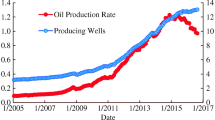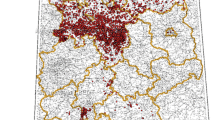Abstract
Wellbore attributes (i.e., deviation, casings and plugging characteristics) for 85 wells in the St. Lawrence Lowlands basin of southern Quebec were compiled from drilling reports and abandonment programs to provide an overview of the abandoned well characteristics and to establish a diagnosis on the long-term reliability of the completion and abandonment practices carried out by the companies since the beginning of oil and gas exploration. Using these data, the conventional and unconventional wells were divided into four categories: (1) conventional wells drilled before 1950, (2) conventional wells drilled between 1950 and 1970, (3) conventional wells drilled after 1970 and shale gas wells (all drilled after 2000). Very little information was available for wells drilled before 1950. More information was available for the wells drilled from 1950 to 1970 which is considered a transition period between old and modern technology. Conventional and unconventional wells drilled after 1970 were generally well documented and their attributes corresponded to API standards. A decision tree, inspired from the methodology proposed by Watson and Bachu (SPE Drill Complet 24(1):115–126, 2009. https://doi.org/10.2118/106817-PA), was then created to assess the potential of leakage of each of the conventional and unconventional wells using the compiled attributes. The factors defining the probability of well leakage were wellbore deviation, height of cement in casing annuli (partially or fully cemented), type of abandonment plugs (cement or mechanical plugs) and drilling date (before or after 1970). Among the 85 wells assessed by this tree, the probability of leakage was higher than 50% for 55 wells (65% of wells). Wellbore deviation and lack of information on the construction and abandonment methods were respectively the primary and secondary causes of high probability of leakage of these wells.




Similar content being viewed by others
References
AER, Alberta Energy Regulator (1990) Directive 009: guide to minimum requirements for cementing intermediate or production casing, multiple editions. Energy Resources Conservation Board, Calgary, Alberta, Canada, 17p
AER, Alberta Energy Regulator (2009) Directive 010: minimum casing design requirements. Energy Resources Conservation Board, Calgary, Alberta, Canada, 25p
AER, Alberta Energy Regulator (2016) Directive 020: well abandonment. Energy Resources Conservation Board, Calgary, Alberta, Canada, 56p
API, American Petroleum Institute (2000) Environmental guidance document: well abandonment and inactive well practices for U.S. exploration and production operations. API Bulletin E3
API, American Petroleum Institute (2002) Specification for cements and materials for well cementing. API specification 10A twenty-third edition, April 2002. ANSI/API 10A/ISO 10426-1-2001
API, American Petroleum Institute (2009) Hydraulic fracturing operations, well construction and integrity guidelines. API guidance document HF1, First Edition, October 2009
Azar JJ, Robello Samuel G (2007) Drilling engineering, PennWell Corporation, 1421 South Sheridan Road, Tulsa, Oklahoma, 74112-6600 USA. ISBN-13: 978-1-59370-072-0
Bol G, Grant H, Keller S, Marcassa F, De Rozieres J (1991) Putting a stop to gas channeling. Schlumberger Oilfield Rev 3(2):35–43
Bonett A, Pafitis D (1996) Getting to the root of gas migration. Schlumberger Oilfield Rev 8(1):36–49
Boyd D, Al-Kubti S, Khedr OH, Khan N, Al-Nayadi K, Degouy D, Elkadi A, Al-Kindi Z (2006) Reliability of cement bond log interpretations compared to physical communication tests between formations. In: Abu Dhabi international petroleum exhibition and conference, Society of Petroleum Engineers, Abu Dhabi, UAE, 5–8 November. SPE Paper 101420-MS. https://doi.org/10.2118/101420-ms
BAPE, Bureau d’Audiences Publiques sur l’Environnement (2011) Développement durable de l’industrie des gaz de schiste au QuébecRép., 336 pp, Bureau d’audiences publiques sur l’environnement, Québec, Canada
Clark HC (1987) Mechanical design considerations for fracture-treating down casing strings. SPE Drill Eng 2(2): 116–126. SPE Paper 14370-PA. https://doi.org/10.2118/14370-pa
Comité de l’Évaluation Environnementale Stratégique sur le gaz de schiste (CEES) (2012) L’industrie du gaz de Schiste dans les Basses-Terres du Saint-Laurent, Québec, Canada: Scénarios de développement, 36 pp, Quebec, Que., Canada
Comité de l’Évaluation Environnementale Stratégique sur le gaz de schiste (CEES) (2014) Rapport Synthèse de l’évaluation environnementale stratégique sur le gaz de Schiste [Synthesis report of the strategic environmental assessment on shale gas], 292 pp, Quebec, Que., Canada
Cooke CE Jr, Kluck MP, Medrano R (1983) Field measurements and annular pressure and temperature during primary cementing: SPE 11206. J Pet Technol 35:1429–1438
Council of Canadian Academies (CCA) (2014) Environmental impacts of shale gas extraction in Canada, The expert panel on harnessing science and technology to understand the environmental impacts of shale gas extraction, Ottawa, Ont., Canada
Davies RJ, Almond S, Ward RS, Jackson RB, Adams Ch, Worrall F, Herringshaw LG, Gluyas JG, Whitehead MA (2014) Oil and gas wells and their integrity: implications for shale and unconventional resource exploitation. Mar Pet Geol 56:239–254. https://doi.org/10.1016/j.marpetgeo.2014.03.001
Dusseault M, Jackson R (2014) Seepage pathway assessment for natural gas to shallow groundwater during well stimulation, in production, and after abandonment. Environ Geosci 21(3):107–126
Dusseault MB, Gray MN, Nawrocki PA (2000) Why oil wells leak: cement behavior and long-term consequences. In: International oil and gas conference and exhibition in China. Society of Petroleum Engineers. SPE 64733
Erno B, Schmitz R (1996) Measurements of soil gas migration around oil and gas wells in the Lloydminster area. J Can Pet Technol 35(7):37–46. https://doi.org/10.2118/96-07-05
Girard P (1993) Projet de fermeture sécuritaire des puits, la région des Basses-Terres du Saint-Laurent—phase 1 [Well closure project for the Saint-Lawrence Lowlands – Phase 1]. Ministère de l’Énergie et des Ressources, Québec, 1993TA000-01, 122 pp
Globensky Y (1987) Géologie des Basses-Terres du Saint-Laurent. MM 85-02, Ministère de l’Energie et des Ressources, Québec
Harrison SS (1985) Contamination of aquifers by over pressuring the annulus of oil and gas wells. Ground Water 23:317–324
Hossain ME, Al-Majed AA (2015) Fundamentals of sustainable drilling engineering. Co-published by John Wiley & Sons, Inc. Hoboken, New Jersey, and Scrivener Publishing LLC, Salem, Massachusetts. ISBN: 978-0-470-87817-0
Jackson RE, Gorody AW, Mayer B, Roy JW, Ryan MC, Van Stempvoort DR (2013) Groundwater protection and unconventional gas extraction: the critical need for field-based hydrogeological research. Ground Water 51(4):488–510. https://doi.org/10.1111/gwat.12074
King GE, King DE (2013) Environmental risk arising from well-construction failure—differences between barrier and well failure and estimates of failure frequency across common well types, locations and well age. SPE production and operations. SPE paper 16142-PA. https://doi.org/10.2118/166142-pa
Lamontagne Ch (2016) SCVF of Quebec, Canada shale gas wells. Person Commun
Lavoie D, Rivard C, Lefebvre R, Séjourné S, Thériault R, Duchesne MJ, Ahad JME, Wang B, Benoit N, Lamontagne C (2014) The Utica shale and gas play in southern Quebec: geological and hydrogeological syntheses and methodological approaches to groundwater risk evaluation. Int J Coal Geol 126:77–91. https://doi.org/10.1016/j.coal.2013.10.011
Lecourtier M, Cartalos MU (1993) Cementing technology and procedures. Association for research on petroleum drilling and production techniques (ARTEP), Editions Technip, Paris
Moritz A, Helie J-F, Pinti D, Larocque M, Barnatche D, Retailleau S, Lefebvre R, Gelinas Y (2015) Methane baseline concentrations and sources in shallow aquifers from the shale gas-prone region of the St. Lawrence Lowlands (Quebec, Canada). Environ Sci Technol 49(7):4765–4771
Nowamooz A, Lemieux J-M, Molson J, Therrien R (2015) Numerical investigation of methane and formation fluid leakage along the casing of a decommissioned shale-gas well. Water Resour Res 51(6):4592–4620
Rivard C, Lavoie D, Lefebvre R, Séjourné S, Lamontagne C, Duchesne M (2014) An overview of Canadian shale gas production and environmental concerns. Int J Coal Geol 126:64–76. https://doi.org/10.1016/j.coal.2013.12.004
Rowe D, Muehlenbachs K (1999) Isotopic fingerprints of shallow gases in the Western Canadian sedimentary basin: tools for remediation of leaking heavy oil wells. Organ Geochem 30(8):861–871
Séjourné S, Malet X, Lefebvre R, Lavoie D (2013) Synthèse hydrogéologique du shale d’Utica et des unités sus-jacentes (Lorraine, Queenston et dépôts meubles), Basses-Terres du Saint-Laurent, Québec, Canada. Geological Survey of Canada, Open File (7338)
Thériault R (2012) Caractérisation du shale d’Utica et du Groupe de Lorraine, Basses-Terres du Saint-Laurent—Partie 2: interprétation géologique [Charaterization of the Utica Shale and Lorraine Group, St-Lawrence Lowlands – Part 2: Geological interpretation], Rep. DV 2012-04, Géol. Qué., Québec, Canada
U.S. Department of Energy (USDOE) (2009) State oil and natural gas regulations designed to protect water resources, U.S. Department of Energy, Office of Fossil Energy, Natl. Energy Technol. Lab., Washington, DC
Vidic RD, Brantley SL, Wandenbossche JM, Yoxtheimer D, Abad JD (2013) Impact of shale gas development on regional water quality. Science 340(6134):1235009-1–1235009-9. https://doi.org/10.1126/science.1235009
Vignes B, Aadnøy BS (2010) Well-integrity issues offshore Norway. SPE Prod Oper 25(2):145–150. https://doi.org/10.2118/112535-PA
Watson TL (2004) Surface casing vent flow repair—a process. Paper presented at the 5th Canadian international petroleum conference, Pet Society of Canada, Calgary, Alberta, Canada, 8–10 June
Watson TL, Bachu S (2009) Evaluation of the potential for gas and CO2 leakage along wellbores. SPE Drill Complet 24(1):115–126. https://doi.org/10.2118/106817-PA
Acknowledgements
The geological map of southern Quebec (Fig. 1) was reproduced from Lavoie et al. (2014), with kind permission from Elsevier. Surface casing vent flows (SCVFs) of shale gas wells in Quebec, Canada were provided by Charles Lamontagne (personal communication; Charles.Lamontagne@mddelcc.gouv.qc.ca) of the Ministère du Développement durable, de l’Environnement et de la Lutte contre les changements climatiques (MDDELCC), Quebec, Canada. The authors thank John Molson and Charles Lamontagne for their collaboration and constructive comments and suggestions on this paper. The authors also thank the Strategic Environmental Evaluation Committee on Shale Gas (CEES) and Ministère de l’Énergie et des Ressources naturelles du Québec (MERN) for commissioning this study and for their financial support.
Author information
Authors and Affiliations
Corresponding author
Rights and permissions
About this article
Cite this article
Nowamooz, A., Comeau, FA. & Lemieux, JM. Evaluation of the potential for gas leakage along wellbores in the St. Lawrence Lowlands basin, Quebec, Canada. Environ Earth Sci 77, 303 (2018). https://doi.org/10.1007/s12665-018-7483-6
Received:
Accepted:
Published:
DOI: https://doi.org/10.1007/s12665-018-7483-6




